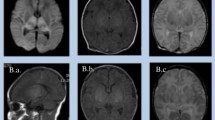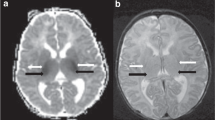Abstract
Background
Deep nuclear gray matter injury in neonatal hypoxic-ischemic encephalopathy (HIE) is associated with worse neurodevelopmental outcomes. We previously published a qualitative MRI injury scoring system utilizing serial T1-weighted, T2-weighted and diffusion-weighted imaging (DWI), weighted for deep nuclear gray matter injury.
Objectives
To establish the validity of the MRI scoring system with neurodevelopmental outcome at 18-24 months.
Materials and methods
MRI scans from neonates with moderate to severe HIE treated with therapeutic hypothermia were evaluated. Signal abnormality was scored on T1-weighted, T2-weighted and DWI sequences and assessed using an established system in five regions: (a) subcortical: caudate nucleus, globus pallidus and putamen, thalamus and the posterior limb of the internal capsule; (b) white matter; (c) cortex, (d) cerebellum and (e) brainstem. MRI injury was graded as none, mild, moderate or severe. Inter-rater reliability was tested on a subset of scans by two independent and blinded neuroradiologists. Surviving infants underwent the Bayley Scales of Infant and Toddler Development-III (Bayley-III) at 18-24 months. Data were analyzed using univariate and multivariate linear and logistic regression.
Results
Fifty-seven eligible neonates underwent at least one MRI scan in the first 2 weeks of life. Mean postnatal age at scan 1 was 4±2 days in 50/57 (88%) neonates and 48/54 (89%) surviving infants underwent scan 2 at 10±2 days. In 54/57 (95%) survivors, higher MRI injury grades were significantly associated with worse outcomes in the cognitive, motor and language domains of the Bayley-III.
Conclusion
A qualitative MRI injury scoring system weighted for deep nuclear gray matter injury is a significant predictor of neurodevelopmental outcome at 18–24 months in neonates with HIE.




Similar content being viewed by others
References
Chau V, Poskitt KJ, Dunham CP et al (2014) Magnetic resonance imaging in the encephalopathic term newborn. Curr Pediatr Rev 10:28–36
Volpe J (2001) Hypoxic-ischemic encephalopathy: clinical aspects in neurology of the newborn. WBS Company, Philadelphia
Jacobs SE, Berg M, Hunt R et al (2013) Cooling for newborns with hypoxic ischaemic encephalopathy. Cochrane Database Syst Rev 1:CD003311
Cowan F, Rutherford M, Groenendaal F et al (2003) Origin and timing of brain lesions in term infants with neonatal encephalopathy. Lancet 361:736–742
Miller SP, Ramaswamy V, Michelson D et al (2005) Patterns of brain injury in term neonatal encephalopathy. J Pediatr 146:453–460
Thayyil S, Chandrasekaran M, Taylor A et al (2010) Cerebral magnetic resonance biomarkers in neonatal encephalopathy: a meta-analysis. Pediatrics 125:e382–e395
Skranes JH, Cowan FM, Stiris T et al (2015) Brain imaging in cooled encephalopatic neonates does not differ between four and 11 days after birth. Acta Paediatr 104:752–758
Bell E, Rasmussen LA, Mazer B et al (2015) Magnetic resonance imaging (MRI) and prognostication in neonatal hypoxic-ischemic injury: a vignette-based study of Canadian specialty physicians. J Child Neurol 30:174–181
Massaro AN, Kadom N, Chang T et al (2010) Quantitative analysis of magnetic resonance images and neurological outcome in encephalopathic neonates treated with whole-body hypothermia. J Perinatol 30:596–603
Rutherford M, Ramenghi LA, Edwards AD et al (2010) Assessment of brain tissue injury after moderate hypothermia in neonates with hypoxic-ischaemic encephalopathy: a nested substudy of a randomised controlled trial. Lancet Neurol 9:39–45
Wintermark P, Hansen A, Soul J et al (2011) Early versus late MRI in asphyxiated newborns treated with hypothermia. Arch Dis Child Fetal Neonatal Ed 96:F36–F44
Rutherford M, Srinivasan L, Dyet L et al (2006) Magnetic resonance imaging in perinatal brain injury: clinical presentation, lesions and outcome. Pediatr Radiol 36:582–592
Mercuri E, Rutherford M, Barnett A et al (2002) MRI lesions and infants with neonatal encephalopathy. Is the Apgar score predictive? Neuropediatrics 33:150–156
Rutherford MA, Pennock JM, Counsell SJ et al (1998) Abnormal magnetic resonance signal in the internal capsule predicts poor neurodevelopmental outcome in infants with hypoxic-ischemic encephalopathy. Pediatrics 102:323–328
Hunt RW, Neil JJ, Coleman LT et al (2004) Apparent diffusion coefficient in the posterior limb of the internal capsule predicts outcome after perinatal asphyxia. Pediatrics 114:999–1003
Shankaran S, Barnes PD, Hintz SR et al (2012) Brain injury following trial of hypothermia for neonatal hypoxic-ischaemic encephalopathy. Arch Dis Child Fetal Neonatal Ed 97:F398–F404
Barkovich AJ, Hajnal BL, Vigneron D et al (1998) Prediction of neuromotor outcome in perinatal asphyxia: evaluation of MR scoring systems. AJNR Am J Neuroradiol 19:143–149
Bonifacio SL, Glass HC, Vanderpluym J et al (2011) Perinatal events and early magnetic resonance imaging in therapeutic hypothermia. J Pediatr 158:360–365
D'Alton M (2014) Executive summary: neonatal encephalopathy and neurologic outcome, second edition. Report of the American College of Obstetricians and Gynecologists' task force on neonatal encephalopathy. Obstet Gynecol 123:896–901
Bednarek N, Mathur A, Inder T et al (2012) Impact of therapeutic hypothermia on MRI diffusion changes in neonatal encephalopathy. Neurology 78:1420–1427
Shankaran S, Laptook AR, Ehrenkranz RA et al (2005) Whole-body hypothermia for neonates with hypoxic-ischemic encephalopathy. N Engl J Med 353:1574–1584
Mathur AM, Neil JJ, McKinstry RC et al (2008) Transport, monitoring, and successful brain MR imaging in unsedated neonates. Pediatr Radiol 38:260–264
Johnson S, Moore T, Marlow N (2014) Using the Bayley-III to assess neurodevelopmental delay: which cut-off should be used? Pediatr Res 75:670–674
Barkovich AJ (2006) MR imaging of the neonatal brain. Neuroimaging Clin N am 16:117-135, viii-ix
Mulkey SB, Yap VL, Swearingen CJ et al (2012) Quantitative cranial magnetic resonance imaging in neonatal hypoxic-ischemic encephalopathy. Pediatr Neurol 47:101–108
Barnett A, Mercuri E, Rutherford M et al (2002) Neurological and perceptual-motor outcome at 5–6 years of age in children with neonatal encephalopathy: relationship with neonatal brain MRI. Neuropediatrics 33:242–248
de Vries LS, Jongmans MJ (2010) Long-term outcome after neonatal hypoxic-ischaemic encephalopathy. Arch Dis Child Fetal Neonatal Ed 95:F220–F224
Gonzalez FF, Miller SP (2006) Does perinatal asphyxia impair cognitive function without cerebral palsy? Arch Dis Child Fetal Neonatal Ed 91:F454–F459
Gano D, Chau V, Poskitt KJ et al (2013) Evolution of pattern of injury and quantitative MRI on days 1 and 3 in term newborns with hypoxic-ischemic encephalopathy. Pediatr Res 74:82–87
McKinstry RC, Miller JH, Snyder AZ et al (2002) A prospective, longitudinal diffusion tensor imaging study of brain injury in newborns. Neurology 59:824–833
Azzopardi D, Edwards AD (2010) Magnetic resonance biomarkers of neuroprotective effects in infants with hypoxic ischemic encephalopathy. Semin Fetal Neonatal Med 15:261–269
de Vries LS, Groenendaal F (2010) Patterns of neonatal hypoxic-ischaemic brain injury. Neuroradiology 52:555–566
Chalak LF, DuPont TL, Sanchez PJ et al (2014) Neurodevelopmental outcomes after hypothermia therapy in the era of Bayley-III. J Perinatol 34:629–633
Acknowledgements
The authors wish to thank Anthony Barton (no conflicts of interest) for his efforts in coordinating the project and the infants and families for their generous assistance and dedication. In addition, we are grateful for the support from the Thrasher Foundation and the Washington University KL2 program.
Funding was provided by the Thrasher Foundation, the Washington University Institute of Clinical and Translational Sciences KL2 Training Program (NIH/NCATS KL2 TR000450-08), and the Eunice Kennedy Shriver National Institute of Child Health & Human Development of the National Institutes of Health under award number U54 HD087011 to the Intellectual and Developmental Disabilities Research Center at Washington University.
Author information
Authors and Affiliations
Corresponding author
Ethics declarations
Conflicts of interest
None
Electronic supplementary material
ESM 1
MRI scoring sheet (PDF 38 kb)
Rights and permissions
About this article
Cite this article
Trivedi, S.B., Vesoulis, Z.A., Rao, R. et al. A validated clinical MRI injury scoring system in neonatal hypoxic-ischemic encephalopathy. Pediatr Radiol 47, 1491–1499 (2017). https://doi.org/10.1007/s00247-017-3893-y
Received:
Revised:
Accepted:
Published:
Issue Date:
DOI: https://doi.org/10.1007/s00247-017-3893-y




